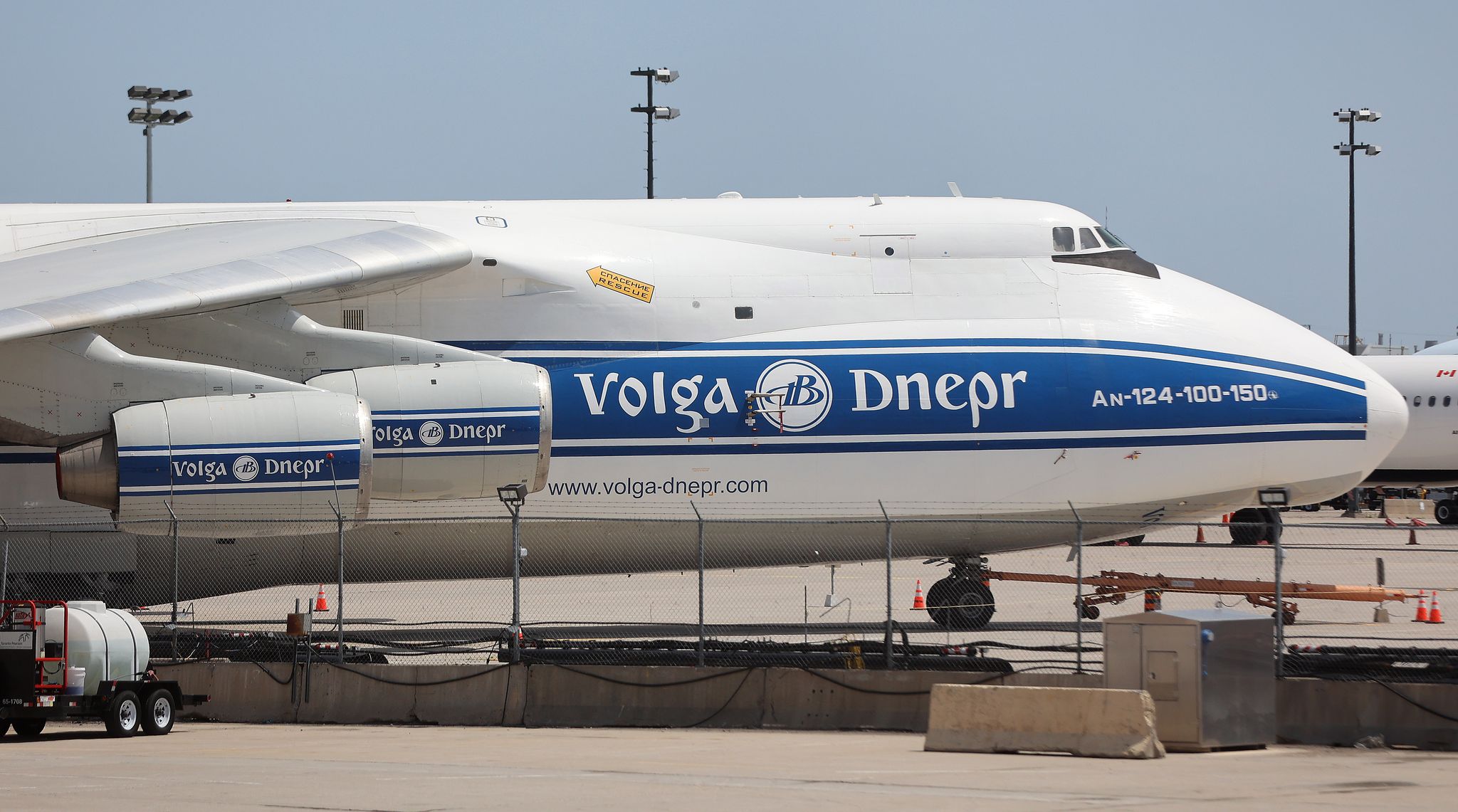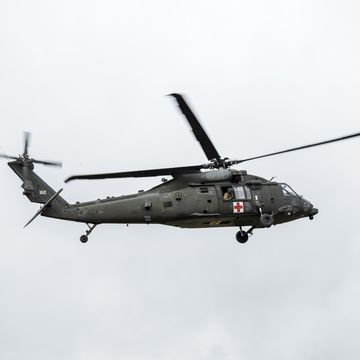For over a year, a massive An-124 Ruslan cargo plane has been sitting on the tarmac of Toronto’s Pearson International Airport. The jet, with serial numbers RA-82078, had landed there on February 27, 2022 carrying a cargo of Covid-19 rapid tests—just four days after Russia launched its massive invasion of Ukraine. That same day, Canada’s transport minister closed Canadian airspace to all Russian-operated aircraft, keeping the An-124 grounded.
Following an April 11, 2023 meeting between Ukrainian and Canadian prime ministers Denys Shmyhal and Justin Trudeau, Ottawa now plans to confiscate the plane and give it to Ukraine. This decision was made on the basis of a legal ruling by a Ukraine court that Russia’s Federal Air Transport Agency had illegally approved air-worthiness certification for all twelve of Volga Dnepr’s An-124s.
Antonov Airlines, a branch of the Ukrainian state-owned company which designed the An-124, will undoubtedly receive the craft. And to add insult to injury, Russia is still on the hook for over $330,000 USD equivalent in parking fees for the over 400 days spent in impoundment.
Aptly codenamed Condor by NATO, the 200-ton jet—capable of hefting 150 tons of cargo and roughly 50 tons of fuel—is the reigning T-Rex of heavy lift aviation. It’s the largest operational aircraft in the world, ever since Ukraine’s even larger An-225 cargo jet was destroyed in the battle of Hostomel airport last year. A uniquely upgraded An-124-100-150M was also damaged in the Hostomel fight.
Since the early 1990s, these big haulers have been chartered by both civilian and military clients for rapid delivery of heavy, large-volume cargos including railway cars, industrial turbines, helicopters, tanks and, once, even a whale.
Antonov Airlines retains a fleet of five An-124-100s which were re-homebased at Halle airport in Leipzig, Germany after the Russian invasion.
Upon resuming operations last year, Antonov Airlines anticipated that the aircraft would fly up to 385 more missions, involving 1,270 landings. In August, the An-124s were all renamed after Ukrainian cities that experienced heavy fighting in the war, including Bucha, Irpin, Kharkiv, Mykolaiv, Ohktyrka, Kherson and Mariupol.
Three more Volga-Dnepr An-124s (serial numbers RA-82043, 82045 and 82046) are also under impoundment, gathering dust at Leipzig.
Germany’s plans for these impounded aircraft (one of which lacks engines) remain unclear. Besides Antonov and Volga-Dnepr, the craft type is operated by Russia’s military, and one is flown by UAE-based Maximus Airlines.
Flight of the Condor
Ukraine used to be the sole proprietor of the world’s largest aircraft—the 314-ton An-225 Mriya (“Dream”) transport plane, operated by its domestic Antonov Airlines from Hostomel Airport near Kyiv. This was effectively an enlarged An-124 with a different tail, specially built to carry the Soviet Buran space shuttle.
When Putin launched his invasion of Ukraine on February 23, Russian paratroopers seized Hostomel in a helicopter landing operation, planning to use it as a launch pad to capture the Ukrainian capital. To their surprise, the Ukrainians counterattacked quickly and vigorously with air and ground forces, preventing additional troops from landing in the area and causing Putin’s attempted snatch-and-grab of Kyiv to collapse in shambles.
When Ukrainian troops recaptured Hostomel for good on April 2, they found Mriya in its burn-out hangar, its front section smashed by shelling.
The loss of the likely irrecoverable Mriya left it’s smaller—but still ginormous—sister, the Antonov An-124 Ruslan, with the title of largest in the world.
The An-124 began development in the 1970s as “Project 400”, a Soviet counterpart to the huge American C-5 Galaxy heavy-haul cargo jet. The An-124 closely resembled the C-5 Galaxy, including its folding nose cone used to facilitate loading and offloading.
However, the Soviets brought technical flourishes to the concept, including a computerized fly-by-wire flight controls system and both ground-scanning navigation and weather radars. The primarily aluminum aircraft also incorporated 5% lightweight composite materials, as well as ultra-hard (and ultra-expensive) titanium flooring for the cargo deck.
A total of 24 massive wheels on 10 gear-fairings supported the aircraft, each with built in auxiliary power units. Those wheels can be deflated to crouch the jet down for ease of unloading. Propulsion was provided by four Lotarev D-18T turbofan engines—the first fuel-efficient high-bypass engines developed by the Soviet Union—which could also reverse thrust to assist with landing.
Ultimately, compared to the C-5, the An-124 boasted 20% more internal volume and 17% higher maximum cargo weight. The massive aircraft could carry up to three main battle tanks, five BMP infantry fighting vehicles, or an entire mini submarine. Its cargo bay even included a 30-ton capacity crane to facilitate loading and unloading.
Unlike the C-5, however, the Ruslan lacked inflight-refueling capability, and its main hold wasn’t fully pressurized to support passengers or paratroopers—though it does have an upper passenger deck with seating for 88 personnel.
Despite making its first flight in December of 1982, followed by an unveiling at the Paris Airshow in 1985, the An-124 wasn’t fully operationally reliable until 1991. Altogether, 53 An-124s were built (including the prototype), with parts for two more left unassembled. Antonov built eighteen of these in Ukraine, while the remainder were built by the Ulyanovsk factory in Russia.
Of these aircraft, 22 were built or converted into the civilian An-124-100 aircraft, stripped of military systems and fit with improved D-18T series 3 engines with much longer service lives (18,000 hours). Four An-124s were lost in deadly accidents that claimed 97 lives between them, with a fifth An-124 heavily damaged in a belly landing after losing engine power.
Even before the dissolution of the Soviet Union, however, Antonov began arranging international cargo flights in partnership with British company Air Foyle, which included delivering U.S. Patriot missiles during the Persian Gulf War.
This began a trend of the An-124 fleet seemingly ending up providing more transportation services to NATO-member militaries than Russia’s armed forces, particularly during ‘War on Terror’-era operations in the Middle East and Afghanistan. These services included delivering Canadian Leopard 2 tanks for combat in that latter period. The partnership with Air Foyle ended in 2005, and Antonov instead leased twelve An-124s to a consortium with Russia called Volga-Dnepr, while also operating its own Antonov Airlines.
The -100s were gradually modernized, with new avionics allowing downsizing of flight crew from six to four in the -100M submodel. Then, in 2005, Antonov also refit a unique An-124-100-150M aircraft with a D-18T Series 4 engine, boasting 10% increased thrust, in turn and increasing max carrying capacity and range to 150 tons and 9,631 miles, respectively.
An-124 cargo missions included transporting the 4th-century Axium obelisk—weighing 160 tons—from Rome back to Ethiopia, the dismantled components of a U.S. Navy EP-3E spy plane that forced landed in China’s Hainan island, a Falcon Heavy rocket, a massive Putzmeister concrete pump airlifted from Germany to Japan to help cool of the melt-down Fukushima reactor, and huge quantities of masks and tests during the peak COVID-19 era.
The An-124 also established world records for the heaviest-ever lift—carrying a 187.6-ton German generator to Armenia—and the longest unrefueled flight ever, traversing over 12,520 miles in 25 hours and 30 minutes.
A Condor also starred in the James Bond film Die Another Day (see 4:14 in below clip).
The Volga-Dnepr partnership fell apart after Russia’s initial invasions of Ukraine in 2014. However, the airline was able to continue operations in Western countries until sanctions in 2022 grounded 4 of its An-124s.
According to an assessor, Russia’s assault on Hostomel caused damages that would require $3 billion and five years to repair. Besides the desolation of the Mriya, it also resulted in the destruction of an An-74 and Ant-26-100 aircraft in Antonov’s fleet, and damaged the unique An-124-100-150M.
The Mriya is unlikely to be restorable—though, given adequate resources, Antonov could attempt to assemble a second never-completed An-225 airframe. That option, however, is estimated to cost roughly $500 million.
Russian military An-124s have been active in the war in Ukraine, used to transport Tochka-U and Iskander ballistic missiles for attacks. Ukraine’s now Leipzig-based An-124s also are active. While reportedly prioritizing missions transporting humanitarian and military aid for the Ukrainian government and NATO, they also still fly commercial flights, such as transporting a gas turbine from the UAE to the United Kingdom.
Sébastien Roblin has written on the technical, historical, and political aspects of international security and conflict for publications including 19FortyFive, The National Interest, MSNBC, Forbes.com, Inside Unmanned Systems and War is Boring. He holds a Master’s degree from Georgetown University and served with the Peace Corps in China. You can follow his articles on Twitter.













